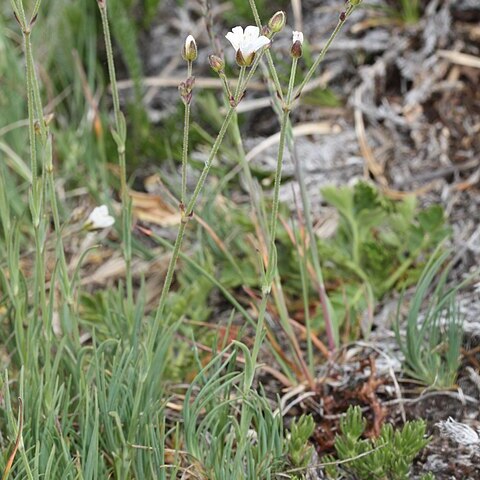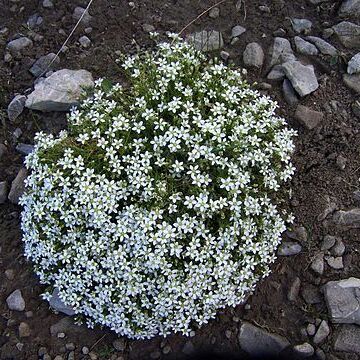Annual, biennial or perennial herbs, glabrous or pubescent, prostrate and cespitose to diffuse and spreading, the stems somewNhat resilient and occasionally suffruticose below. Leaves opposite, petiolate to sessile and slightly amplexicaul, exstipulate, subulate and coriaceous to broadly elliptic and membranaceous. Flowers axillary or terminal, solitary or in dichasial cymes. Sepals 5, connate only at the base if at all. Petals 5, rarely lacking, wrhite or occasionally red, entire or shallowly emarginate. Stamens 10, rarely 5; anthers versatile; 2-celled, longitudinally dehis-cent; filaments flattened and usually united below to form a slightly perigynous disk. Ovary superior, 3-(2-5-) carpellate with 3 (2-5) filiform styles free to their bases; ovules numerous on basal placentae. Capsule dehiscing into as many entire to deeply emarginate valves as there are styles; seeds numerous, cochleate, smooth to tuberculate, estrophiolate, the embryo curved about the perisperm.
Herbs, annual to perennial, rarely (not in Australia) undershrubs; stems branching, glabrous to densely minutely scabrous. Leaves opposite, linear to elliptic, ovate, or orbicular, usually flat, acute to apiculate; margins entire, ciliate; stipules absent; bracts herbaceous. Flowers solitary, terminal or in dichasial, often few-flowered cymes, usually 5-merous, bisexual. Sepals usually 5, free. Petals usually 5 (rarely 4 or absent), shorter than the sepals, entire or slightly emarginate, white. Stamens (8–) 10. Ovary 1-celled; styles 3, rarely 2, 4 or 5. Capsule ampulliform to ± conical, usually slightly exceeding the calyx, opening by twice as many teeth as styles. Seeds numerous, discoid (±reniform) or slightly nautiloid, tuberculate.
Annual, biennial, or perennial herbs, rarely low, spiny shrubs or cushion plants. Leaves exstipulate, more or less joined at the base, suborbicular to linear or setaceous. Inflorescences cymose, axillary or more often terminal, few-or many-flowered, flowers sometimes solitary. Sepals 5 (or 4), free, herbaceous with a narrow or wide scarious margin, persistent, 1-or 3-nerved with a prominent midrib. Petals 5 (0), white to pinkish, entire or slightly emarginate. Stamens mostly 10, the 5 outer ones with basal glands. Ovary of 3 (2-5) carpels with as many short styles. Capsule opening with twice as many teeth or, more rarely, bifid valves. Seeds usually numerous, black, rarely reddish brown, spherical to reniform, tuberculate.
Herbs annual or perennial, rarely biennial. Stems erect or rarely creeping, often caespitose or pulvinate. Leaves opposite, rarely whorled; leaf blade linear to elliptic, ovate, or orbicular, usually flat, margin entire. Flowers solitary or numerous in cymes, actinomorphic. Sepals 4 or 5, apex entire, rarely emarginate. Petals 4 or 5, sometimes absent, apex entire to toothed, 2-cleft, or fimbriate. Stamens (2--5 or 8 or)10. Ovary 1-loculed; ovules numerous. Styles 2 or 3(--5). Capsule ovoid, obovoid, or globose, usually shorter than persistent sepals, rarely equaling or longer than them, 3-or 6-valved. Seeds reniform or subovoid, flattened, smooth, tuberculate, or narrowly winged.
Annual to perennial herbs. Hairs glandular and/or eglandular or 0. Lvs opposite, exstipulate, linear-subulate to orbicular. Infl. cymose, few-to many-flowered; bracts and sepals herbaceous or with scarious margins; epicalyx 0. Sepals (4)-5, free. Petals (4)-5, white, rarely pink, entire; coronal scales 0. Stamens 10 or fewer. Styles (2)-3-(5). Fr. an ovoid to cylindric capsule, dehiscing by twice as many acute teeth as the styles, sessile. Seeds many, reniform, smooth or tuberculate, not winged.
Fls solitary or in terminal cymes; sep 5; pet 5, white, entire to emarginate; stamens normally 10; styles (2)3(–5); ovary unilocular; ovules numerous; primary valves of the capsule 3, entire or 2-cleft; seeds ± reniform; low annual or perennial herbs without stipules. (Minuartia, Moehringia, Sabulina) 250, widespread


